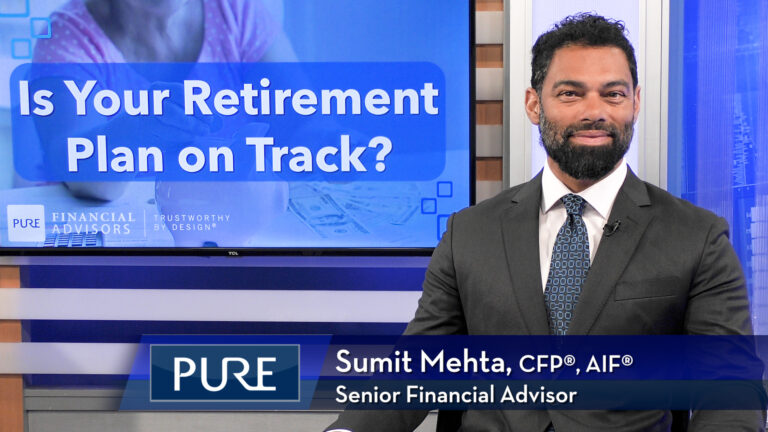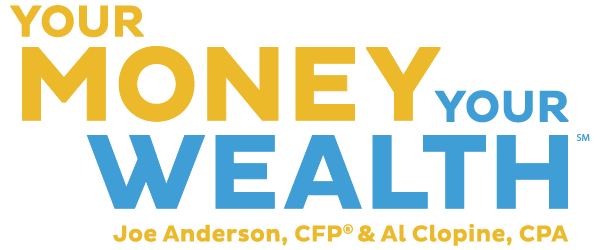Taxes can be one of the most significant expenses you’ll face over your lifetime. Maximizing your savings and keeping more of your hard-earned money during retirement is essential for long-term financial security. Pure’s Financial Advisor, Alexandra Swanson, CFP®, shares tax-saving strategies to help you build a more secure future.
She discusses:
- Transfer assets to tax advantage accounts
- Tax loss harvesting to offset gains
- Qualified Charitable Distributions
- Asset location
Transcript
One of the biggest expenses retirees have is taxes. In addition to budgeting for housing, healthcare, and hobbies – considering your tax bill should be top of mind as you are planning your retirement expenses. Today, we are going to chat about ways you can save on taxes and keep more money working for you and your family.
Strategy 1: Transfer assets to tax advantage accounts
Many retirees have a drop in income when they step away from work. This may allow you to strategically move assets from pre-tax accounts that are saddled with a future tax bill to tax-free accounts via Roth Conversions when you’re at a low bracket. This creates more flexibility on taxes and access in the future. Figuring out where you fall in your tax bracket and reassessing your income and distribution options each year will help you maximize income at the lowest tax brackets for long-term tax savings and efficiency. This strategy works particularly well for folks with high balances in pre-tax retirement savings like 401(k)s and traditional IRAs.
Strategy 2: Tax loss harvesting to offset gains
If you have saved into non-retirement accounts, considering a strategy called tax-loss harvesting may allow you to create tax opportunities, especially in times when markets are volatile. The idea is that you sell securities to lock in losses which will offset some income – up to $3,000 a year. Any additional losses can be carried forward year over year. Locking in losses doesn’t mean you have to get out of the market. You can strategically reinvest your assets to maintain growth potential while simultaneously utilizing the losses for tax efficiency.
Strategy 3: Qualified Charitable Distributions
For those who are charitably inclined, there are a number of ways to increase the tax efficiency of how you give your money away. If you give money on an annual basis a qualified charitable distribution, or QCD, may make sense. The strategy is to send money directly from your pre-tax retirement account to the charity of your choice. If the money never passes through your hands, it goes to the Charity tax free without showing up as income for you. There are several rules around this strategy, but used appropriately, it can help lower income taxes without having to itemize charitable contributions. A QCD can also satisfy required minimum distributions (RMDs). Other considerations for the charitably inclined are to ensure that beneficiaries on accounts are set up to increase tax efficiency. Friends and family can be listed on tax favorable accounts such as Roth IRAs and non-retirement accounts, and charities can be listed on pre-tax accounts to make sure more money goes to the intended party, rather than to taxes.
Strategy 4: Asset location
What types of investments you hold in each of your accounts can also have significant impact on the total taxes that you pay over time. Your investments should not look the same across all of your accounts. I usually say you want to be your most aggressive version of yourself in your Roth IRA. Because all that growth is tax free, you want to have your highest growth assets in that account. In non-retirement accounts it makes sense to hold investments that have their own tax efficiency since there is no tax deferral. Income generating assets are best held in tax-deferred accounts to minimize the tax drag on income until you’re ready to use it.
These are just some tax savings strategies in retirement. With the uniqueness of every personal situation and every portfolio, it’s important to find that solutions that work best with your goals and asset mix. To learn more about tax savings in retirement and what strategies may work for you, contact Pure Financial Advisors for a free tax analysis.
Subscribe to our YouTube channel.
IMPORTANT DISCLOSURES:
• Investment Advisory and Financial Planning Services are offered through Pure Financial Advisors, LLC, a Registered Investment Advisor.
• Pure Financial Advisors LLC does not offer tax or legal advice. Consult with your tax advisor or attorney regarding specific situations.
• Opinions expressed are subject to change without notice and are not intended as investment advice or to predict future performance.
• Investing involves risk including the potential loss of principal. No investment strategy can guarantee a profit or protect against loss in periods of declining values.
• All information is believed to be from reliable sources; however, we make no representation as to its completeness or accuracy.
• Intended for educational purposes only and are not intended as individualized advice or a guarantee that you will achieve a desired result. Before implementing any strategies discussed you should consult your tax and financial advisors.
CFP® – The CERTIFIED FINANCIAL PLANNER® certification is by the CFP Board of Standards, Inc. To attain the right to use the CFP® mark, an individual must satisfactorily fulfill education, experience and ethics requirements as well as pass a comprehensive exam. 30 hours of continuing education is required every 2 years to maintain the certification.














